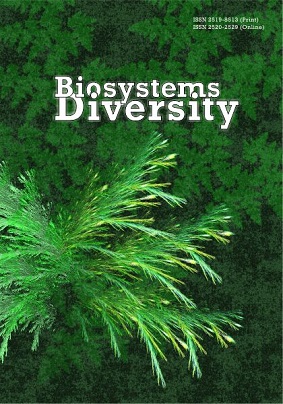Часова динаміка угруповань зоопланктону різнотипних водойм Ічнянського національного природного парку
The temporal dynamics of zooplankton communities of different types of water bodies within Ichniansky National Park
Author(s): V. M. Trokhymets, Z. V. BurianSubject(s): Human Ecology, Sociobiology, Present Times (2010 - today)
Published by: Дніпропетровський національний університет імені Олеся Гончара
Keywords: zooplankton; protected area; Ukraine;
Summary/Abstract: In recent decades, the influence of anthropogenic impact on aquatic ecosystems has increased. This has led to a restructuring of aquatic ecosystems and affected the structural and functional organization of groups of aquatic organisms, causing qualitative and quantitative changes. Particular attention is drawn to the different types of water bodies of protected areas like Ichnyansky National Park, which is located in Ichnyansky district of Chernihiv region. This park is a newly created one, so the reduction in intensity of anthropogenic pressure can be traced within its waters. Zooplankton plays an important role in the functioning of trophic networks because it transfers energy from producers and primary consumers to young fish and planktonophagous fish. Therefore, three main groups of zooplankton were chosen as the object of study: rotifers (class Eurotatoria), cladocerans (class Branchiopoda, order Cladocera), different age stages of copepods (class Copepoda), and also ostracods (Class Ostracoda). The zooplankton used as research material was collected in the daytime in spring (April), summer (late July – early August) and autumn (late September – early October) in the years 2015–2016 from ten experimental stations. During this period 81 species of zooplankton were recorded within heterogeneous reservoirs of Ichniansky National Park. Monogonont rotifers (subclass Monogononta) included 35 species (43% of all species) and bdelloid rotifers (subclass Bdelloidea), cladocerns, comprised 28 species (35%), and copepods included 18 species (22%). The faunal range of zooplankton over different years and seasons was characterized by the predominance of the rotator complex in spring, rotator-cladocerans and cladocerans in summer, and of the cladocerans complex in autumn. This was due to the formation during spring and summer of favourable conditions in the waters for filter feeders, which consist generally of rotifers and cladocerans. In autumn the water released large amounts of organic matter that caused a reduction in the species diversity of rotifers. Zooplankton also is characterized by the considerable ecological diversity. The range of environmental groups of zooplankton over two years was characterized by a predominance of the pelagic and benthic group of phytophiles. Pelagic representatives included 35 (43%) of 81 species, the bottom group – 20 (25%), phytophiles – 26 (32%). Rotifers dominated in the pelagic group – 18 (51%) species out of 35, and cladocerans – among the bottom group – 10 (50%) species out of 20. Zooplankton species also are distinguished by their feeding type. They represented three trophic groups: peaceful – 64 (79%) out of 81 species, omnivorous – 6 (7%) and predators – 11 (14%). Quantitative indicators of zooplankton at most stations in different seasons were defined as “very low” (less than 5,000 ind./m3 and less than 0.3 g/m3 ), “low” (5,000–50,000 ind./m3 and 0.3–1.0 g/m3 ), “below average” (5,000–50,000 ind./m3 and 0.3–1.0 g/m3 ) rates, occasionally – "average" (51–250,000 ind./m3 and 1.1–5.0 g/m3 ), “medium high” (501,000–1,000,000 ind./m3 and 1.1–5.0 g/m3 ). High densities of zooplankton densities were recorded in spring for a temporary reservoir and amounted to 3,016,000 ind./m3.
Journal: Biosystems Diversity
- Issue Year: 25/2017
- Issue No: 2
- Page Range: 124-131
- Page Count: 8
- Language: Ukrainian

